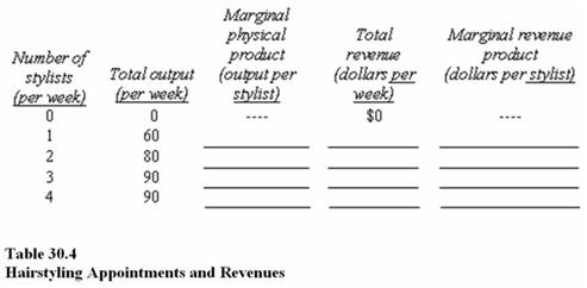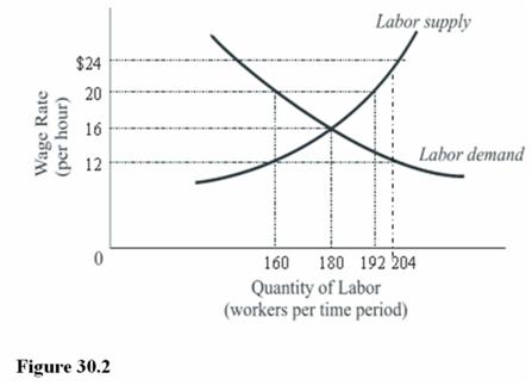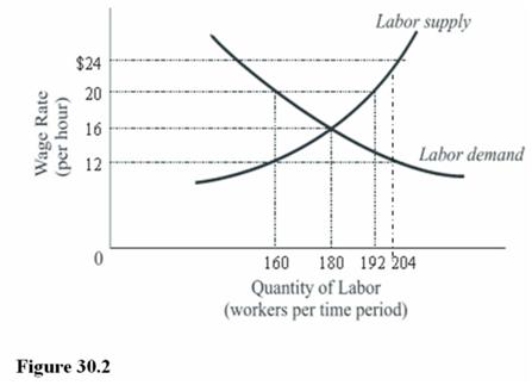A) Labor supply.
B) Labor demand.
C) Derived supply.
D) Derived demand.
Correct Answer

verified
A
Correct Answer
verified
True/False
The market supply of labor represents the sum of all individual labor supply decisions.
Correct Answer

verified
Correct Answer
verified
Multiple Choice
The marginal revenue product establishes
A) An upper limit to the wage rate an employer is willing and able to pay.
B) A lower limit to profit on the sale of a unit of output.
C) A lower limit to the productivity of a worker.
D) A lower limit to the wage rate demands of laborers.
Correct Answer

verified
Correct Answer
verified
Multiple Choice
The marginal revenue product of labor curve is the firm's
A) MPP of labor curve divided by the wage rate.
B) Marginal revenue curve.
C) Demand curve for labor.
D) Marginal physical product multiplied by the wage rate.
Correct Answer

verified
Correct Answer
verified
Multiple Choice
One In the News article is titled "Challenging Work and Corporate Responsibility Will Lure MBA Grads." In the headline, which of the following determinants of labor supply is most explicitly mentioned?
A) Tastes.
B) Taxes.
C) Prices of consumer goods.
D) Expectations regarding prices of consumer goods.
Correct Answer

verified
A
Correct Answer
verified
Multiple Choice
 In Figure 30.2, unemployed labor at the equilibrium wage is equal to
In Figure 30.2, unemployed labor at the equilibrium wage is equal to
A) 34 workers.
B) 28 workers.
C) Zero workers.
D) 10 workers.
Correct Answer

verified
Correct Answer
verified
Multiple Choice
 Table 30.4 shows how many hairstyling appointments a hair salon can schedule per week based on the number of stylists.In the spaces provided, compute the marginal physical product (MPP) of the hairstylists, total revenue, and the marginal revenue product of the stylists, assuming that a hairstylist charges $60 per appointment.In Table 30.4 suppose a hairstylist is paid $700 per week.How many hairstylists should a profit-maximizing salon hire?
Table 30.4 shows how many hairstyling appointments a hair salon can schedule per week based on the number of stylists.In the spaces provided, compute the marginal physical product (MPP) of the hairstylists, total revenue, and the marginal revenue product of the stylists, assuming that a hairstylist charges $60 per appointment.In Table 30.4 suppose a hairstylist is paid $700 per week.How many hairstylists should a profit-maximizing salon hire?
A) 1.
B) 2.
C) 3.
D) 4.
Correct Answer

verified
Correct Answer
verified
Multiple Choice
The labor supply curve will be positively sloped if the substitution effect of wages is
A) Equal to the income effect of wages.
B) Stronger than the income effect of wages.
C) Weaker than the income effect of wages.
D) Negative.
Correct Answer

verified
Correct Answer
verified
Multiple Choice
Which of the following would not shift the market demand for labor, ceteris paribus?
A) The wage paid to labor.
B) The demand for final products.
C) The productivity of labor.
D) The number of employers.
Correct Answer

verified
Correct Answer
verified
Multiple Choice
 The number of people employed in the competitive market depicted in Figure 30.2 at a wage of $20.00 per hour is
The number of people employed in the competitive market depicted in Figure 30.2 at a wage of $20.00 per hour is
A) 0.
B) 160.
C) 180.
D) 192.
Correct Answer

verified
Correct Answer
verified
Multiple Choice
The labor supply curve will be negatively sloped if the substitution effect of wages is
A) Weaker than the income effect of wages.
B) Stronger than the income effect of wages.
C) Equal to the income effect of wages.
D) Negative.
Correct Answer

verified
Correct Answer
verified
True/False
President Obama wanted to increase the federal minimum wage.
Correct Answer

verified
Correct Answer
verified
Multiple Choice
Joe Sabia, an assistant professor of public policy at American University in Washington, DC, says that a 10 percent increase in the minimum wage reduces retail employment by 1 percent and reduces employment among young workers by 3.4 percent.If President Obama is successful increasing the minimum wage by 30 percent as explained in "Obama Wants $9.50 Minimum Wage," we can expect
A) Employment to decrease by about 30 percent and prices to increase.
B) Unemployment to increase by about 30 percent and prices to decrease.
C) Retail employment to decrease by about 3 percent and young workers'employment to decrease by about
10) 2 percent.
D) Prices to increase and unemployment to increase by about 3 percent.
Correct Answer

verified
Correct Answer
verified
Multiple Choice
Which of the following is not true about the demand for factors of production?
A) It is derived from the demand for the goods and services the firm produces.
B) It is a function of diminishing marginal physical product.
C) It depends on the firm's expected sales and output.
D) It is a function of the elasticity of supply.
Correct Answer

verified
Correct Answer
verified
True/False
A decreasing marginal utility of income contributes to the upward slope of an individual's supply curve.
Correct Answer

verified
Correct Answer
verified
Multiple Choice
According to the In The News article "Mauer, Twins Agree to Eight-Year, $184 Million Extension," high salaries of professional baseball player are due to
A) A player having a high marginal physical product.
B) A large supply of players of that caliber.
C) A player having a high marginal revenue product.
D) A player having a high diminishing marginal product.
Correct Answer

verified
Correct Answer
verified
Multiple Choice
If the demand for hair gel increases, the effect on the hair gel manufacturing job market will be to
A) Increase the demand for labor and increase equilibrium wages.
B) Reduce the supply of labor and increase equilibrium wages.
C) Decrease the demand for labor and reduce equilibrium wages.
D) Have no impact on equilibrium wages.
Correct Answer

verified
A
Correct Answer
verified
Multiple Choice
If there is an increase in the number of workers who want to work as accountants, there will be a
A) Leftward shift of the labor supply curve.
B) Rightward shift of the labor supply curve.
C) Movement up the labor supply curve to the right.
D) Movement down the labor supply curve to the left.
Correct Answer

verified
Correct Answer
verified
Multiple Choice
If the price of the output produced by a particular type of labor decreases, which of the following shifts should occur in the labor market for the particular type of labor?
A) Demand for labor should shift to the left.
B) Supply of labor should shift to the left.
C) Demand for labor should shift to the right.
D) Supply of labor should shift to the right.
Correct Answer

verified
Correct Answer
verified
Multiple Choice
 In Figure 30.2, the equilibrium wage rate is
In Figure 30.2, the equilibrium wage rate is
A) $24 per hour.
B) $20 per hour.
C) $16 per hour.
D) $12 per hour.
Correct Answer

verified
Correct Answer
verified
Showing 1 - 20 of 149
Related Exams